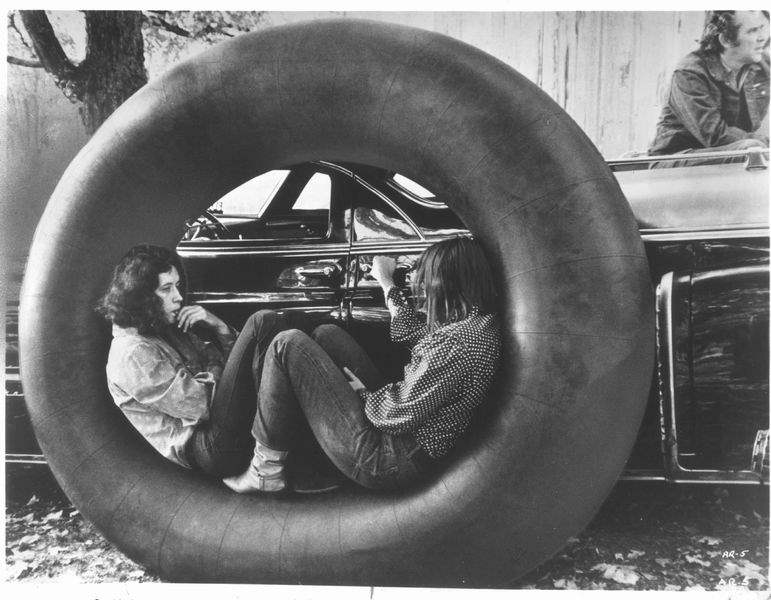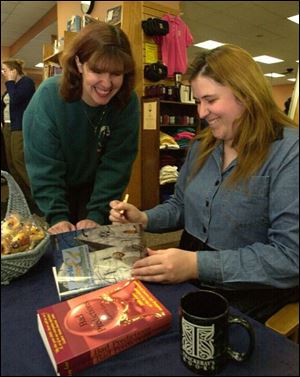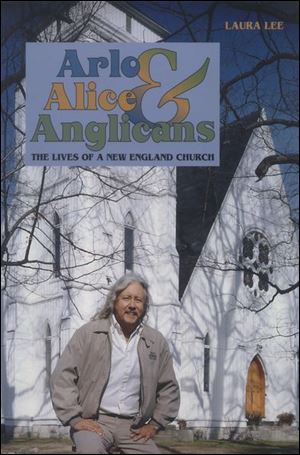
Uncovering past of `Alice's Church'
11/18/2000
Arlo Guthrie, left, played himself in the film 'Alice's Restaurant,' baed on his hit single.
ho

Laura Lee, right, signs a copy of her book, pictured at right, for Jennifer Hunt of Swanton at Thackeray's Books.
Laura Lee was just entering the world when the children of the 1960s were reveling at Woodstock, but their signature film, Alice's Restaurant, and its setting in a New England church always have fascinated her.
For years, she hoped someone would write a book about the former Trinity Episcopal Church in Housatonic, Mass. Finally, she saw that if such a book were to be written, she would have to write it.
Just in time for the Thanksgiving holiday, which is memorialized in “The Alice's Restaurant Massacree,” the famed Guthrie ballad that led to the film, Lee's Arlo, Alice, and Anglicans: the Lives of New England Church, has hit the bookstores.
It is a tale that has begged to be told, and Lee, who spent her junior high and high school years in the northwest Ohio community of Bowling Green, has not only set down the history of Trinity Church, but has managed to set the record straight on a few key points.
The 31-year-old Stephentown, N.Y., author, who was in Toledo last weekend to sign copies of her book at Thackeray's, figures she must have heard the fabled “Alice's Restaurant” ballad sometime during her childhood, even though her '50s-era parents were more likely to play hits like “At the Hop” on the family record player.
Later, when Arlo Guthrie's name came up in a conversation while Lee was an intern at an alternative rock radio station, she heard herself explaining, “You know ... `Alice's Restaurant,'” even though she wasn't sure how she knew that. She subsequently rented the video, bought the album, and fell in love with the 18-minute song that recounts Guthrie's arrest for littering on Thanksgiving after he and a companion illegally dumped garbage from the Brocks' church house on a Housatonic hillside.

The book's jacket cover.
As Lee began her research for the book about the legendary church of musical and film renown, what surprised her most about the “Alice's Restaurant” story was just how true the song is. Even though the church was never a restaurant, Alice Brock, who lived in it with her husband, Ray, did run a restaurant in the town. And their home in the church, if not the commune of the film, was a place for young people to hang out.
“Everything that he recounts basically is just [Guthrie] in a humorous way talking about what happened to him. There was an Officer Obie - Police Chief William Obanhein. Alice did have a restaurant. There really was a blind judge that Arlo went before, and Officer Obie really had photos of the garbage for evidence. All these little details were true.”
One important detail that Lee was able to uncover was exactly how Guthrie managed to get out of the draft for the Vietnam war. Over time, Lee said, people have come to think of “Alice's Restaurant” as the story of how the singer's arrest for littering made him ineligible for the draft, even though the song only suggests that.
The facts are that Guthrie's criminal record for littering meant his eligibility had to be reviewed by a morality-waiver determination board, which automatically sent such files on to the Department of Defense.
“There was a long list of things that would get you disqualified as a security risk: links to subversive organizations, ties with known Communists,” Lee said. But an arrest for littering was not one of them. Lee suspects that Guthrie's relationships with his singer father, Woody Guthrie, and folksinger Pete Seeger, a family friend, probably were enough to put a “Z” on his government file, indicating he was a security risk. Woody Guthrie had dabbled in Communism and Seeger was blacklisted by the House Un-American Activities Committee for his socialist leanings.

Arlo Guthrie, left, played himself in the film 'Alice's Restaurant,' baed on his hit single.
Although all that was interesting to Lee, it was the Trinity Church that drew her into the “Alice's Restaurant” project.
When she first saw the movie, she writes in the book, she was struck by the scene in which the Brocks are waiting to take possession of the church while a deconsecration ceremony is being conducted inside.
As the camera cut to an old woman at the service, Lee couldn't help but wonder about what the church had meant to her. “Had her great-grandparents been there when they laid the cornerstone of the building? ... Had she been married at that altar? Had her children been baptized there?”
A Midwesterner and a Unitarian by birth, Lee had no natural connection to the life of an Episcopal church in the Berkshires of New England, but something about the old church and its relationship to the modern era caught her interest.
To plumb its history, she leafed through church records, newspaper archives, old photos, and newspaper and magazine articles, collected memories of neighbors, and conducted personal interviews.
“There aren't a lot of people left who went there when it was a church, certainly not when it was active. But people were happy to share their memories and talk about what it was so that part of its history would not be forgotten.”
One of those was the Rev. Pierce Middleton, the former rector of St. James Church in Great Barrington, Mass., the parent church to Trinity before it was sold. He helped Lee track down the church records, which was no small feat given the fact that Trinity hadn't been a church since 1962.
The records turned up at the Episcopal Diocese of Western Massachusetts, where, coincidentally, someone had just decided to find out what was in an assortment of boxes in the basement. By the time Lee got there, the boxes had been sorted enough to determine which one contained Trinity's records.
Lee had less success finding descendants of the church's pillars, namely Evelyn Burgert and John Coffing, both of whom are honored in plaques on the wall of the church, and Fanny Coffing Bostwick, niece of John. None had children.
However, through seven months of digging and writing, Lee developed an intimate acquaintance with the church's history and a strong attachment to the place.
“In some ways I feel more of a bond to that church, like it's my place, than I ever did before, because you can't spend that much time on a subject, learning about all the people who went there, all the different phases in its history, what it meant to so many different people without feeling very connected to it, without feeling like part of the story. So it's a special place to me. It really is my church, my community place now.”
Arlo Guthrie purchased the church and re-established it as the Guthrie Center, an interfaith church, in 1991.
Lee said Guthrie was interested in bringing spirituality back to the building, but not tying it to a particular faith. The center invites speakers from different religious groups and next month will do an interfaith winter celebration.
“For the most part,” Lee said, “it's a space available for people to come and meditate or reminisce about Alice's Restaurant.” The center also offers community programs like a folk music series and an oral history gathering that brings seniors and youth together.
Lee said the building has retained its ambience as a church. Guthrie has moved the altar up to the choir loft under the rose window. On it are symbols of different world religions and lots of candles. “It does have spiritual nooks and crannies in it if people want to use it for that,” Lee said. The pews were long ago replaced with folding chairs, but the church still has a small organ.
Guthrie, who posed for the cover of Lee's book, was aware of the project and in touch with her through the research and writing. “Basically, he made himself available, but he wasn't looking over my shoulder. He was very helpful in terms of things like referring me to people.”
Now that Lee's history of the church is done, she admits to having lost the sense of magic about it that she had going into the project.
“It's kind of like the difference between when you're first in love with somebody and discovering each other and being married a long time. That warm, comfortable feeling that develops over the years is what I feel now, whereas before it was infatuation.”